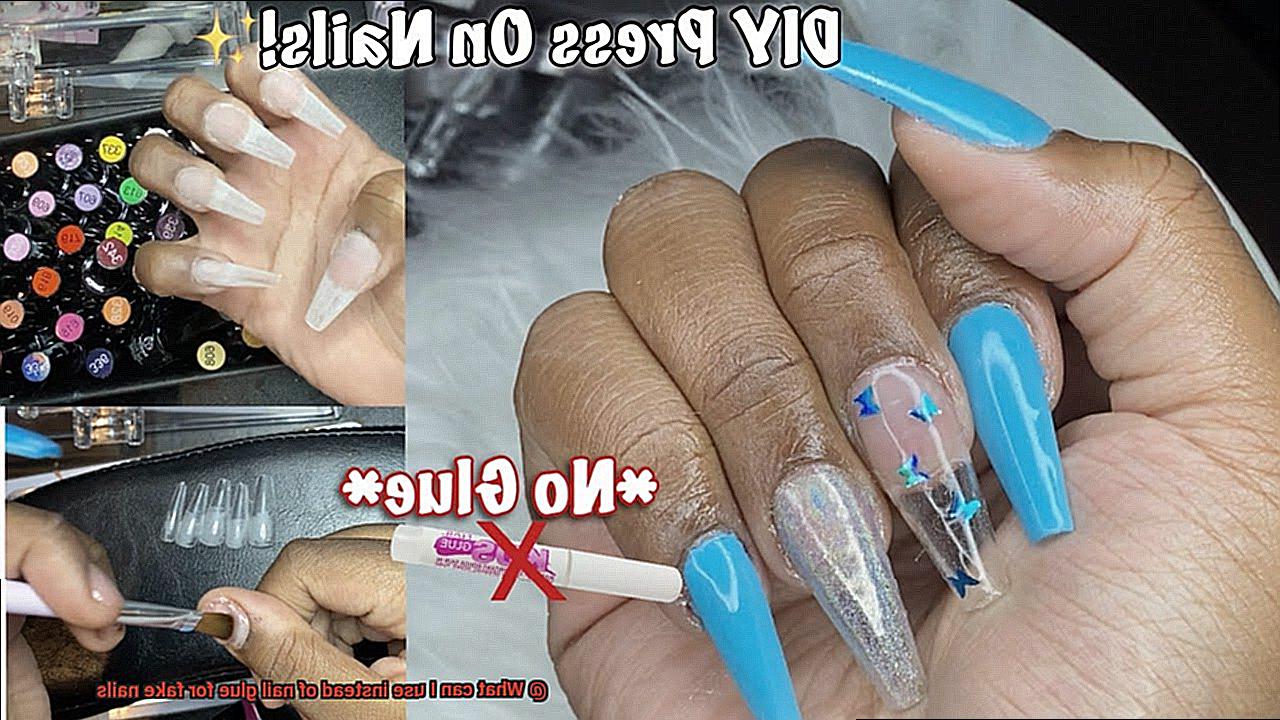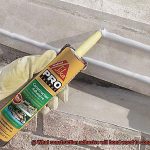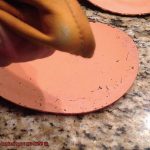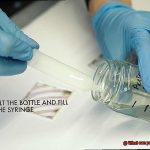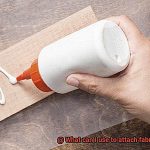Hello, nail aficionados.
Contents
- 1 Adhesive Tabs and Stickers
- 2 Double-Sided Tape or Adhesive Tape
- 3 Liquid Bandage or Glue
- 4 Clear Nail Polish or Top Coat
- 5 Considerations Before Choosing an Alternative to Nail Glue
- 6 Proper Application Techniques for Alternatives to Nail Glue
- 7 Pros and Cons of Using Alternatives to Nail Glue
- 8 Conclusion
Sick and tired of dealing with that pesky nail glue when applying your fake nails? Whether it’s the stench assaulting your senses or the messiness that drives you up the wall, I’ve got some fantastic news for you.
Brace yourself, because there’s a whole world of alternatives out there just waiting to be explored. Say goodbye to traditional nail glue and hello to adhesive tabs, double-sided tape, and so much more.
Get ready to rock those flawless fake nails without any of the hassle. Ready to dive in?
Let’s go.
Adhesive Tabs and Stickers
Adhesive tabs and stickers offer a convenient and mess-free alternative that can give you a flawless manicure in no time. In this article, we will explore the advantages and disadvantages of using adhesive tabs and stickers for fake nails. So, let’s dive in.
Advantages:
- Easy to use: Adhesive tabs and stickers are incredibly user-friendly. With a simple peel and press technique, you can achieve a professional-looking manicure without any fuss or mess.
- Gentle on natural nails: Unlike nail glue, which can potentially damage or weaken your natural nails, adhesive tabs and stickers offer a gentle solution. They do not require harsh solvents for removal, making them ideal for individuals with weak or brittle nails who want to avoid further damage.
- Durability: Adhesive tabs and stickers can provide a secure hold for several days, allowing you to enjoy your beautiful manicure for an extended period. However, it’s important to consider factors such as nail type, lifestyle, and daily activities that may impact their longevity.
- Hassle-free removal: Removing fake nails applied with adhesive tabs or stickers is a breeze. Simply peel them off without causing any damage or leaving behind residue on your natural nails.
- Availability and variety: Adhesive tabs and stickers are widely available in beauty supply stores, drugstores, and online retailers. They come in various sizes and shapes, allowing you to customize your manicure according to your preferences.
Disadvantages:
- Limited holding power: While adhesive tabs and stickers can provide a secure hold for several days, they may not be as strong or long-lasting as nail glue. Individuals with an active lifestyle or those who frequently use their hands may need to reapply the adhesive more often to maintain the desired look.
- Less versatile: Adhesive tabs and stickers are specifically designed for fake nails, which means they may not be as versatile for other nail art techniques or applications. Nail glue offers more flexibility in terms of usage.
Adhesive tabs and stickers are an excellent alternative to traditional nail glue for individuals seeking a convenient, mess-free, and gentle solution for applying fake nails. They offer ease of use, gentle removal, and can provide a secure hold for several days.
With their availability and variety in sizes and shapes, adhesive tabs and stickers are a popular choice among those who want a flawless manicure without the need for nail glue.
However, it’s important to consider their limitations and suitability for individual preferences and lifestyles.
So go ahead, give adhesive tabs and stickers a try, and enjoy a hassle-free manicure experience.
Adhesive tabs and stickers provide many advantages when it comes to applying fake nails. First and foremost, they are incredibly easy to use. With a simple peel and press technique, you can achieve a professional-looking manicure without any fuss or mess. This makes them ideal for beginners or those who want a quick and hassle-free solution.
Furthermore, adhesive tabs and stickers are gentle on natural nails. Unlike nail glue that can damage or weaken your nails, these alternatives do not require harsh solvents for removal. This makes them a suitable choice for individuals with weak or brittle nails who want to avoid further damage.
Durability is another benefit of adhesive tabs and stickers. They can provide a secure hold for several days, allowing you to enjoy your beautiful manicure for an extended period. However, it is important to consider factors such as nail type, lifestyle, and daily activities that may impact their longevity.
Removing fake nails applied with adhesive tabs or stickers is also hassle-free. Simply peel them off without causing any damage or leaving behind residue on your natural nails. This makes changing your fake nail designs or removing them altogether a breeze.
Double-Sided Tape or Adhesive Tape
In this blog post, we will delve into the battle between double-sided tape and adhesive tape for attaching fake nails. Whether you’re a nail enthusiast seeking a quick and easy manicure or someone who loves changing their nail design frequently, this article will provide you with all the information you need to make an informed decision.
Advantages of Double-Sided Tape:
- Easy application: Simply peel off the backing of the pre-cut strip and stick it onto your natural nail. Voila.
- Formidable hold: Double-sided tape guarantees a secure bond, ensuring your fake nails stay in place throughout the day.
- Temporary solution: If you love switching up your nail design frequently, double-sided tape allows for easy removal and replacement without damaging your natural nails.
- Gentle on nails: Unlike traditional nail glue, double-sided tape is kind to your nails, leaving them undamaged and strong.
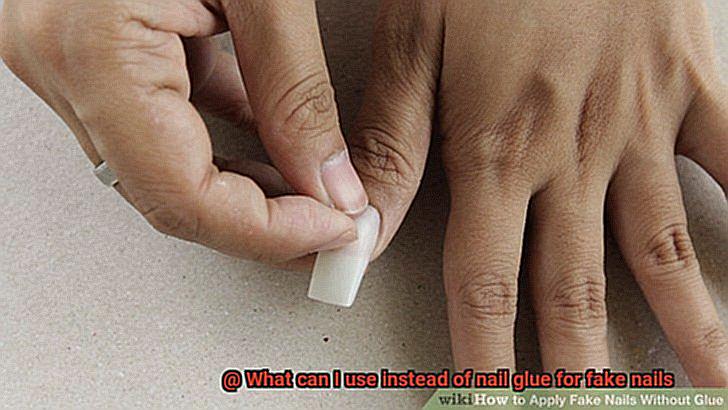
Advantages of Adhesive Tape:
- Versatility at its finest: Adhesive tape comes in various widths and lengths, allowing for customization based on your needs. Cut it into smaller pieces for precise application.
- Enduring hold: Known for its strong adhesive properties, adhesive tape provides a secure hold that can last for several days.
- Effortless removal: When it’s time to bid farewell to your fake nails, adhesive tape can be effortlessly peeled off without any discomfort or damage to your natural nails.
Disadvantages:
- Limited longevity: While double-sided tape and adhesive tape offer temporary solutions for attaching fake nails, they may not match the longevity of traditional nail glue. Exposure to water and oils can weaken their adhesive properties, causing the fake nails to loosen or lift.
- Unsuitable for strenuous activities: If you lead an active lifestyle or engage in activities that put strain on your nails, double-sided tape or adhesive tape may not be the best option. They are more prone to failure under pressure compared to traditional nail glue.
Liquid Bandage or Glue
In this article, we will delve into the world of liquid bandage as an alternative to nail glue and explore the pros and cons of each option.
When it comes to attaching fake nails, liquid bandage offers several advantages that make it a worthy contender. Let’s take a closer look at its benefits:
Flexibility:
Unlike nail glue, which can harden and become brittle over time, liquid bandage remains pliable. This means that the fake nails can move naturally with your own nails, offering a comfortable and seamless experience.
So whether you’re hitting the gym, typing away at your keyboard, or simply going about your day, liquid bandage allows you to maintain your active lifestyle without worrying about your fake nails coming loose.
Strong Adhesion:
Liquid bandage provides a strong bond between your natural nail and the artificial nail. This means that your fake nails stay securely in place throughout the day, even during activities that involve water or friction. However, it’s important to note that the effectiveness of liquid bandage may vary depending on factors such as the type of fake nails used and individual nail conditions.
Easy Application:
Using liquid bandage as an alternative to nail glue is a breeze. Start by preparing your natural nails – clean them thoroughly and ensure they are dry. Trim and shape your nails as desired before applying the liquid bandage. To apply, use either the brush applicator provided or a cotton swab to create a thin layer on your natural nails, being careful to avoid the cuticles.
Allow it to dry for a few seconds until it becomes tacky. Then, carefully press the fake nails onto your natural nails, starting from the cuticle area and working towards the tip. The result? A flawless and secure bond that will last.
While liquid bandage offers several advantages, there are some drawbacks to consider:
Shorter Longevity:
Liquid bandage may not have the same longevity as nail glue. Depending on factors such as individual nail conditions and the type of fake nails used, you may find that the fake nails start to loosen or come off after a few days or weeks. In such cases, reapplying the liquid bandage or using a nail glue specifically designed for artificial nails may be necessary to maintain a long-lasting hold.
Variability in Effectiveness:
As with any product, the effectiveness of liquid bandage can vary from person to person. Factors such as the type of fake nails used and individual nail conditions may influence how well liquid bandage works for you. It’s important to experiment and find what works best for your unique needs.
Clear Nail Polish or Top Coat
We’ve all experienced that moment when we’re ready to flaunt our fabulous fake nails, only to realize we’re fresh out of nail glue. But fear not, because I have a game-changing alternative for you: clear nail polish or top coat.
Let’s start with the basics. Clear nail polish or top coat can be used as an adhesive for fake nails, giving you that flawless manicure without a trip to the store. What’s even better is that most of us already have a bottle (or ten) of nail polish lying around, making it a super convenient option.
Here’s how it works: First, ensure your natural nails are squeaky clean and free from any oils or residue. This step is crucial to maximize the hold of the polish. Next, apply a thin layer of clear nail polish or top coat onto your nail bed and gently press the fake nail onto it. Hold it in place for a few seconds while the polish dries and sets. Voila – instant adhesion.
It’s important to note that clear nail polish may not provide the same strong hold as traditional nail glue, especially for larger or heavier fake nails. So, it might not be suitable for long-term wear or high-impact activities. However, if you’re just looking for a quick fix or rocking some temporary bling for a special occasion, this method will do the trick.
But wait, there’s more. Clear nail polish or top coat can also be used to seal the edges of your fake nails, preventing them from lifting or peeling. Simply apply a thin layer along the sides and tips of your nails to create a protective barrier.
And here’s the best part: removing clear nail polish or top coat is a breeze. Just grab your trusty nail polish remover and swipe it away.
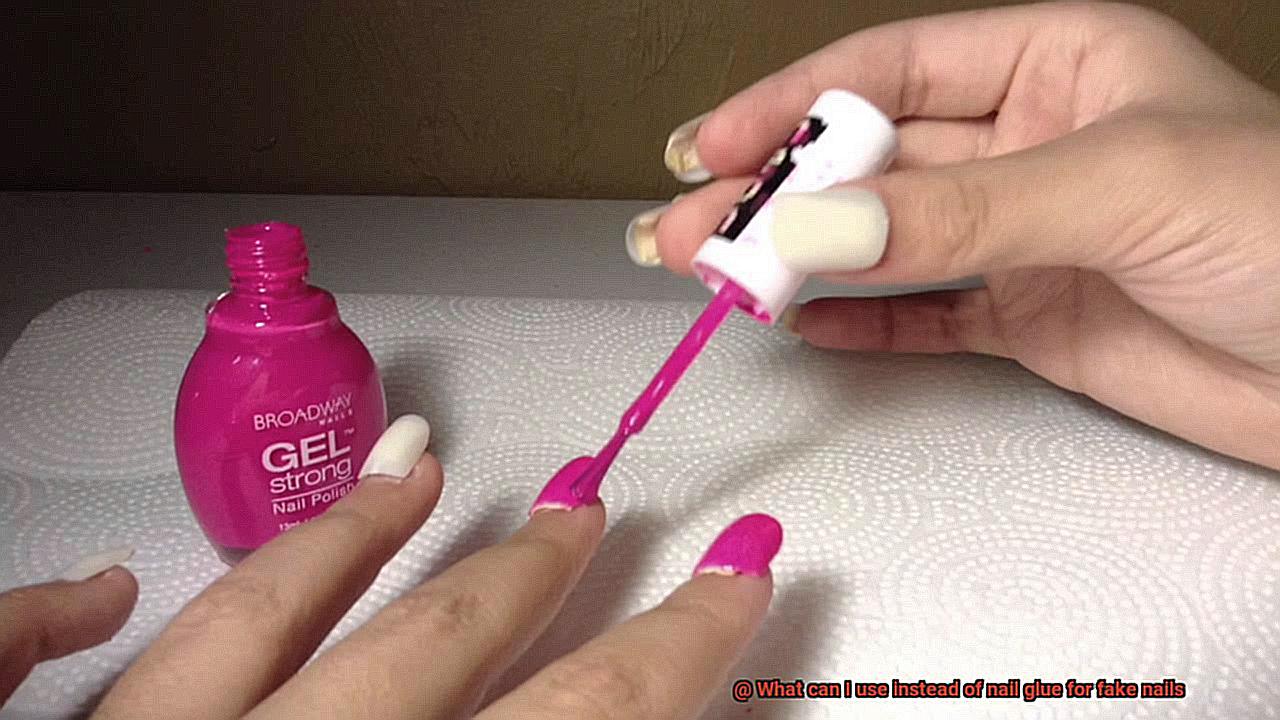
Considerations Before Choosing an Alternative to Nail Glue
When it comes to fake nails, finding the perfect adhesive is crucial for a flawless and long-lasting manicure. While nail glue is a popular choice, exploring alternatives can be beneficial. In this article, we will delve into the essential considerations to keep in mind before choosing an alternative to nail glue.
Type of Fake Nails:
Different types of fake nails require specific adhesives. Press-on nails usually come with their own adhesive tabs, while other options may work better with clear nail polish or top coat. Understanding the requirements of your fake nails is a must before deciding on an alternative.
Durability and Longevity:
Nail glue is renowned for its strong bond and longevity. However, not all alternatives can provide the same level of durability. Evaluate how long you want your fake nails to stay in place and select an alternative that can meet your expectations.
Allergies and Sensitivities:
Some individuals may be allergic or sensitive to the chemicals present in nail glue. Before opting for an alternative, take note of any known allergies or sensitivities to certain substances. This is especially important for those with sensitive skin or a history of reactions to nail products.
Ease of Application and Removal:
Nail glue is relatively easy to apply and remove compared to other alternatives. Consider how simple or complex the application and removal processes are for your chosen alternative. Some options may require additional steps or special techniques, which can be time-consuming and potentially damaging to natural nails.
Cost-Effectiveness:
Nail glue is affordable and widely available. When exploring alternatives, consider their cost and availability. Some options may be more expensive or harder to find, affecting their practicality for regular use.
Compatibility with Nail Types:
Fake nails come in various materials like acrylic, gel, or plastic. Ensure that your chosen alternative is compatible with the specific type of fake nails you are using. Certain alternatives may work better with certain nail materials, so compatibility is crucial for optimal results.
Proper Application Techniques for Alternatives to Nail Glue
Explore the world of nail glue alternatives. If you’re tired of the sticky mess and potential damage caused by traditional nail glue, then you’re in luck. In this article, we’ll dive into two fantastic alternatives and guide you through the proper application techniques for a flawless manicure. Say goodbye to nail glue and hello to hassle-free, gorgeous nails.
Preparing Your Nails:
Before we embark on the alternative options, let’s ensure your nails are ready. Start by thoroughly cleaning your nails, removing any remnants of old polish or debris. Gently push back your cuticles to create a clean canvas for the adhesive.
Alternative 1: Adhesive Tabs
Revolutionize your fake nail application with adhesive tabs. These small strips provide a secure hold without compromising your natural nails. Here’s how to apply them like a pro:
- Peel off the protective backing from the adhesive tab.
- Align the adhesive tab with your natural nail, pressing it down firmly.
- Carefully align the fake nail with your natural nail and press down firmly to secure it in place.
- Repeat these steps for all your nails.
Benefits of Adhesive Tabs:
- Effortless application and removal without damaging your natural nails.
- Reusable – gently remove them and use them again.
Alternative 2: Nail Stickers or Wraps
Add flair to your nails with stylish nail stickers or wraps. These thin adhesive sheets come in various designs and patterns, making nail art a breeze. Follow these steps for perfection:
- Select a sticker or wrap that fits your nail size and shape.
- Peel off the backing and carefully place it on your desired area, smoothing out bubbles or creases.
- Trim any excess sticker or wrap using a nail file or scissors.
- Repeat these steps for all your nails.
Benefits of Nail Stickers or Wraps:
- Endless design possibilities, allowing you to create unique nail art.
- Easy removal with nail polish remover.
Pros and Cons of Using Alternatives to Nail Glue
Well, you’re in luck because there are plenty of alternatives available that offer a healthier and more convenient option for attaching fake nails. In this article, we’ll explore the pros and cons of using alternatives to nail glue, so you can make an informed decision for your next manicure.
Let’s start with the pros. One of the biggest advantages of using alternatives is that they are healthier for your nails. Traditional nail glue often contains harsh chemicals and requires acetone for removal, which can weaken and damage your natural nails over time. Alternatives like adhesive tabs or gel nail stickers are gentler on your nails and don’t require any harsh chemicals for removal.
Another great benefit of using alternatives is the ease of application. Adhesive tabs, for example, are incredibly simple to use. You just peel them off and place them on your nails – no mess or hassle involved. Plus, some alternatives, like magnetic nails or adhesive tabs, can be reused multiple times, saving you money and reducing waste.
For those with sensitive skin, using alternatives can also help minimize the risk of allergic reactions. Traditional nail glues often contain ingredients that can cause discomfort or irritation in some individuals. By opting for alternatives, you can avoid these potential issues and have a more comfortable manicure experience.
Now let’s move on to the cons. One downside of using alternatives is that they may not offer the same level of durability as nail glue. While nail glue can keep your fake nails securely in place for weeks, alternatives like adhesive tabs or gel nail stickers may not provide the same longevity. This means you may need to reapply them more frequently.
Another con is that some alternatives may have limitations when it comes to design options. Nail glue allows for more flexibility in creating intricate patterns or attaching embellishments easily. Alternatives like adhesive tabs or gel nail stickers may not offer as many design choices, limiting your creativity.
Finding the right fit can also be a challenge with alternatives. Nail glues usually come in one size fits all, but some alternatives may have limited options for different nail sizes or shapes. This can result in discomfort or an uneven appearance if you can’t find the right fit.
Lastly, cost can be a factor to consider. While alternatives like adhesive tabs or gel nail stickers may be initially cheaper than nail glue, the cost can add up over time if you need to frequently replace them.
DCcTeariiis” >
Conclusion
When it comes to finding alternatives to nail glue for fake nails, there are a few options that can do the trick.
One popular choice is double-sided adhesive tabs, which provide a strong hold without the mess and potential damage of glue. Another option is nail adhesive stickers, which offer convenience and easy application.
If you prefer a more natural approach, you can try using clear nail polish as a makeshift adhesive. It may not be as strong as traditional glue, but it can work in a pinch.
Just remember to remove them gently and avoid any potential harm to your natural nails.

